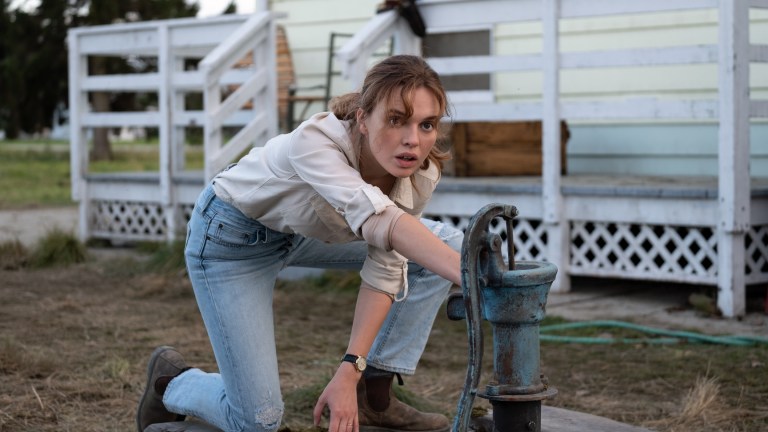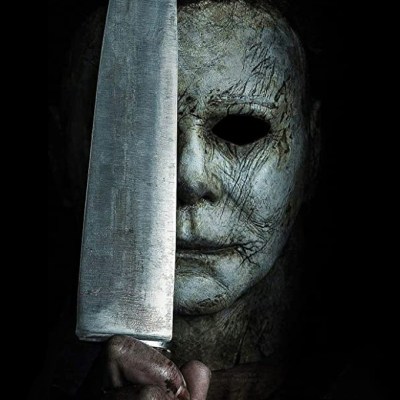How Stephen King Got To Finish The Stand
It’s the end of The Stand as we know it and showrunner Ben Cavell feels fine.

This article contains spoilers for the last two episodes of The Stand.
After nine episodes, the CBS All Access limited series adaptation of Stephen King’s The Stand has come to an end with a final segment written by none other than King himself.
But before we get to that, let’s recap the massive climactic events of last week’s episode eight, which was not titled “The Stand” for nothing.
After setting out on their long walk to New Vegas at the behest of a dying Mother Abagail (Whoopi Goldberg), the little party of Boulder Free Zone leaders finally arrived in Sin City to make their long-awaited stand against Randall Flagg (Alexander Skarsgard) and his minions — minus one.
Stu Redman (James Marsden) has broken his leg in a fall and stayed behind at the bottom of a washout — almost certain to die there — while Larry Underwood (Jovan Adepo), Glen Bateman (Greg Kinnear) and Ray Brentner (Irene Bedard) were captured outside Vegas by Flagg’s right-hand goon Lloyd (Nat Wolff).
In the book, none of the three make it out of Vegas alive — along with thousands of others. Glen is the first to go, shot unceremoniously in his cell by Lloyd for laughing at Flagg to his face. In the just-concluded series, Glen is still shot by Lloyd, but this time during a show trial shown on screens all over the town and meant to rile up Flagg’s depraved supporters.
“It just seemed to me, that for one thing, the murder of Glen in the book never quite made sense to me,” says Ben Cavell as we get on the phone to discuss the end of the series.
He adds that changing Glen’s death from a private cell to a public courtroom changed its impact. “It seemed to me and us that the more dynamic version of that scene was for Glen to be challenging Flagg in front of his people,” he says. “That’s what has consequences for Flagg, is being made to look at all weak in front of the people who give him the adulation from which he derives his power.”
Larry and Ray are scheduled to die next, but not before Flagg’s “bride,” and the mother of his unborn child, Nadine (Amber Heard), hurls herself out a high-rise window after realizing she’s carrying a monster. Her crushed, disfigured head is brought before Larry to soften him up, but his resolve only strengthens, giving him the ability to be strong both for himself and Ray — not to mention the people of Boulder — when they are chained to the bottom of a pool that slowly fills with water.
Their courage sparks a mini-revolt among the denizens of Vegas, including Lloyd. At the same time, Trashcan Man (Ezra Miller) returns from the desert with a nuclear warhead in tow. The stand has been made, the tide has turned against Flagg and now God — or whatever force for good exists in the universe — takes over. A storm of clouds and lightning descend upon the casino — the clouds oddly looking like fingers — to incinerate Flagg, the warhead and New Vegas all at once, along with Larry and Ray.
The hand of God — which is how King describes it in the book and how it was envisioned, as a literal hand, in the 1994 miniseries — has always been problematic for readers and certainly for viewers of the original mini.
“Obviously, there was a lot of talk about how much the hand of God should or should not look like a hand,” says Cavell. “I think we ended up at a very cool hybrid place, where if you want it to be a hand grasping the hotel, it certainly can be. It certainly has those five fingers of cloud coming around it. But it’s not as explicit as the fist in Yellow Submarine or the Monty Python hand coming out of the sky. That’s what we were very concerned about. I’m really happy with where we ended up with that.”
Cavell says that the starting point for the hand of God was the famous photo of the Pillars of Creation, a distant nebula snapped by the Hubble telescope. “If you look at it in a certain way, it kind of looks like fingers, but it doesn’t have to,” says Cavell. “And it is completely naturally occurring. That’s what we wanted. It was very important, at least for me, that you not be required, as a viewer, to accept the characters’ or Mother Abagail’s or anybody’s interpretation of these events.”
By the end of “The Stand,” many of the story’s major characters are dead, and the aftermath of the destruction of Vegas is even visible in the sky from Boulder — where Frannie (Odessa Young) goes into labor and precipitates the events of the ninth and final episode, “The Circle Closes.”
In the final episode, Frannie — keeping hope alive that Stu and the others will return from making their stand — gives birth, but the baby comes down with Captain Trips. However, since Frannie herself is immune, her child inherits her immunity and is able to bounce back from the disease, leaving open the possibility that the superflu will no longer be a part of their lives going forward.
At the same time, Stu — who was discovered and rescued by a returning Tom Cullen (Brad William Henke) — finally arrives home as well. But after a period of rest and recuperation, he and Frannie decide to leave behind a growing Free Zone and journey to Frannie’s hometown of Ogunquit, Maine. But along the way they face one final confrontation.
The episode was written by King himself and incorporates elements from the end of the original novel, the ending of the 1990 expanded edition, and brand new material in which Frannie falls down a well and is badly injured while Stu is out getting supplies. While down there, she has an otherworldly encounter with Flagg, who offers to save her life and provide a comfortable future for her, Stu, the baby and any other future family members in exchange for her fealty.
Frannie firmly refuses the deal, and as Stu arrives back at their camp and struggles to rescue her from the well, he receives unexpected assistance from a young Black girl who — it’s made quite clear — is an incarnation of Mother Abagail sent to help them.
First things first: did the writers’ room of The Stand break the story for the final chapter, or was it wholly developed by the master himself? “We didn’t break it,” says Cavell. “(King) had mentioned that there was this ending that he had been playing with and turning over for 30 years, this thing that had always been nagging him about the ending of the book, which was that Frannie never got her stand…that had always been eating at King. He really wanted to give her a satisfying conclusion to her arc in the book.”
Cavell says that King felt comfortable enough with the way the scripts were going for the rest of The Stand to entrust the creative team with bringing his final chapter to life. “Essentially what we arrived at was, ‘Okay, tell me where you guys are going to be able to leave it at the end of chapter eight, and I’ll pick up there,’” recalls Cavell. Asked if he gave any notes to King on his teleplay, Cavell laughs. “Whenever people ask me, ‘Did you give notes to Stephen King?’ My answer is, ‘Yes. I gave him one note, which was, “Thank you for writing this.”’”
Despite a semblance of hope throughout much of the final episode of The Stand, the show ends on an ominous note taken directly from the last pages of King’s uncut edition of the book: Flagg is reborn and appears on an island before an isolated, primitive tribe, who immediately see the levitating monster — now calling himself “Russell Faraday” — as a god.
“I love the idea that Flagg is eternal and always reborn as this beautiful Alexander Skarsgard avatar, or whatever we decide is the word for how he’s using that form,” says Cavell. “Flagg is the kind of guy who’s not going to let a little defeat like death stop him from his ultimate aim. And of course, the perfect place to go is a place that’s completely isolated, and that the disease hasn’t reached.
“It always felt like such a smart, interesting, inspiring Stephen King ending,” adds Cavell. “To have this ultimate evil, that seems to be eradicated, find a way back into the world, which was lovely, I thought.”
Cavell also says that the re-emergence of Mother Abagail in the form of the young girl — a concept original to this episode — was meant to mirror Flagg’s rebirth. “They are so much, I don’t know, photo negative versions of each other, I think King always felt that there wasn’t a symmetry in Mother Abigail having her own rebirth,” he explains. “I thought it was so smart to make it a very different kind than Flagg’s, where she’s not in her same form… I thought that was really cool and unexpected.”
Now that The Stand has come to its conclusion, Cavell says that the experience was everything he expected it to be. “If you’re going to adapt something that big — in terms of its actual heft, the sprawl of the narrative, and how many people have read it and have been living with it for so long — it should feel big and difficult and unwieldy and enormous. And it did. It felt all of those things. But it also feels like we managed to achieve something that I think is really special, and I just am going to be eternally proud of.”
All nine episodes of The Stand are available to stream on CBS All Access.

